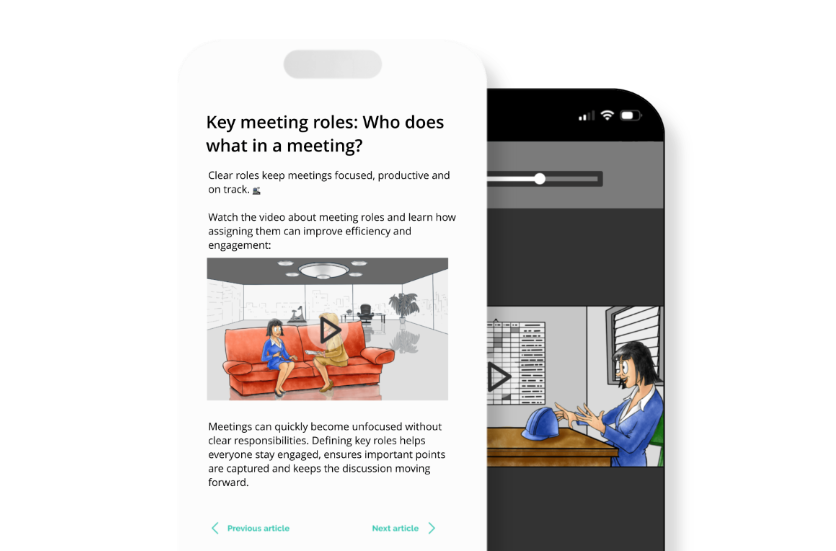
What's a LMS?
LMS’s were first created way back in the 70s as a way to manage training courses. Fast forward to the 2000s and the internet craze was well underway. Training began to move online and the LMS became a logical place to store online courses and curriculums. This brought the added benefit of enrolment and completion tracking using SCORM (an old standard that has now been superseded by xAPI).
Online learning content was “authored” using tools such as Adobe Presenter and Adobe Captivate. And was then hosted on the LMS.
So far, so good.
However, the popularity of LMS’s soon became their downfall. A typical company would add hundreds if not thousands of courses to their LMS.
After all, the more content the better right?
Not quite.
It soon became difficult for staff to find what they were looking for; browsing through thousands of courses to find something relevant was a chore.
On top of that the modern time-strapped knowledge worker has zero time to peruse a thousand course catalog in the hope they’ll find something that’s “just right”.
This leaves us in somewhat of a predicament, as Josh Bersin explains:
Employees simply do not use the LMS unless they have to.
Our research findings
Before we designed and built the Yarno platform, we invested time in speaking with our target market - L&D professionals. We wanted to understand what challenges they faced, in the hope that any product we developed would go someway to solving these.
After interviewing over 100 of these lovely people, one thing was glaringly obvious. The vast majority were frustrated with their LMS,
They told us that their LMS:
- Was only used for mandatory “click-next” compliance training
- Delivered one-sized-fits all training
- Focused on vanity metrics such as enrolment and completion
- Had loads of out of date courses and content
- Was expensive and under-utilised
Our research findings, plus those from industry leaders such as Josh Bersin, showed us that LMS's just weren’t delivering value for their customers.
So it was clear to us what the LMS’s weren’t doing well. But what could we do differently?
Why Yarno is different
Yarno arose from the challenges and frustrations around LMS's. We set out with a clear vision to build a product that solved some real pain points.
Relevant and timely content
We know that learning must be relevant and timely, it must be “just-in-time, just-for-me”. So how do we achieve this?
We began by working with our customers to understand their business objectives and how learning aligns with these. Many LMS’s present vanity metrics such as enrolments, completion and participation. What we want to measure are job impact, business impact and ROI. We want to understand how the learning that’s created will support the business in achieving its objectives.
Next we review all existing learning content through this lens i.e. will this improve the on-the-job performance of our staff? There’s often some really useful learning concepts that are hidden away in huge chunks of one-size-fits all elearning modules. So we seek to extract out the most relevant information and distill it down into question and answer format.
Personalised learning
The one-size-fits-all approach assumes that watching a 1 hour elearning module will benefit every learner equally. But modern knowledge workers need answers, fast. Enter Yarno’s quiz format.
Quizzes are a fun and fast way to introduce and reinforce knowledge. Having to recall what you know rather than simply reviewing it strengthens memory, increasing the chances you’ll remember it again. And when you’re unable to answer a question, you know you need to revisit the material or relearn it.
Receiving immediate feedback on an answer corrects misconceptions and helps learners build correct mental models. And perhaps most importantly, quizzes space learning out over time, which research tells us produces better mastery and longer knowledge retention.
Real-time insights
Enrolment and completion stats may look good, but they’re not actionable. They don’t tell you how well the training was understood by staff or how likely it is to be implemented on-the-job.

With Yarno, learners answer small numbers of questions regularly. This allows us to present real-time insights to both individual learners and their manager into strong and weak knowledge areas.
Managers can support and guide staff based on results, and future training dollars can be invested in topics most relevant to each learner/team.
Easy to manage
In order for learning content to stay relevant and timely, it must be easy to manage. Yarno is based on the premise that learning content will change regularly. And when it does, it needs to be updated quickly and easily.

Since our key learning concepts have been distilled into small chunks (aka microlearning – buzz word alert), they become easier to manage.
Ambiguous or out of date information can be identified and quickly updated. And often it’s the learners themselves who point out inconsistencies in the content. This creates a feedback loop that ensures the integrity of the learning content.
Cost savings rather than expenses
Yarno is designed to maximise the effectiveness of training. Not just store and track it. And more effective training benefits both the company and the staff.
Let’s use mandatory safety training at a construction company as an example. Each year all staff have to undergo 16 hours of safety training to comply with OH&S regulations. For simplicity we’ll assume that 50% of this training is introducing and reinforcing knowledge, and the other 50% is applying this knowledge in practical demonstrations.
This approach costs the developer both in delivering the in-person training (instructor, room, materials etc) and in taking staff off the worksite. It’s also likely that without regular practice, much of what is learnt is forgotten within a few weeks.
How would this example be different with Yarno?
Yarno is designed to reinforce knowledge over time. So the knowledge component of the in-person training could be presented to staff in small chunks throughout the year.
This results in two benefits:
- Reduced in-person training costs - Knowledge based learning can be completed by staff throughout the year using Yarno. This can reduce in-person training time by up to 50%.
- Better use of in-person training time - Now that all staff should have knowledge of the key safety concepts, in-person training time can be used to apply that knowledge in practical and realistic scenarios.
I hope I clearly communicated how Yarno is different to a LMS. Feel free to add a comment below or email me directly at lachy@yarno.com.au with any questions!




.png)

































































